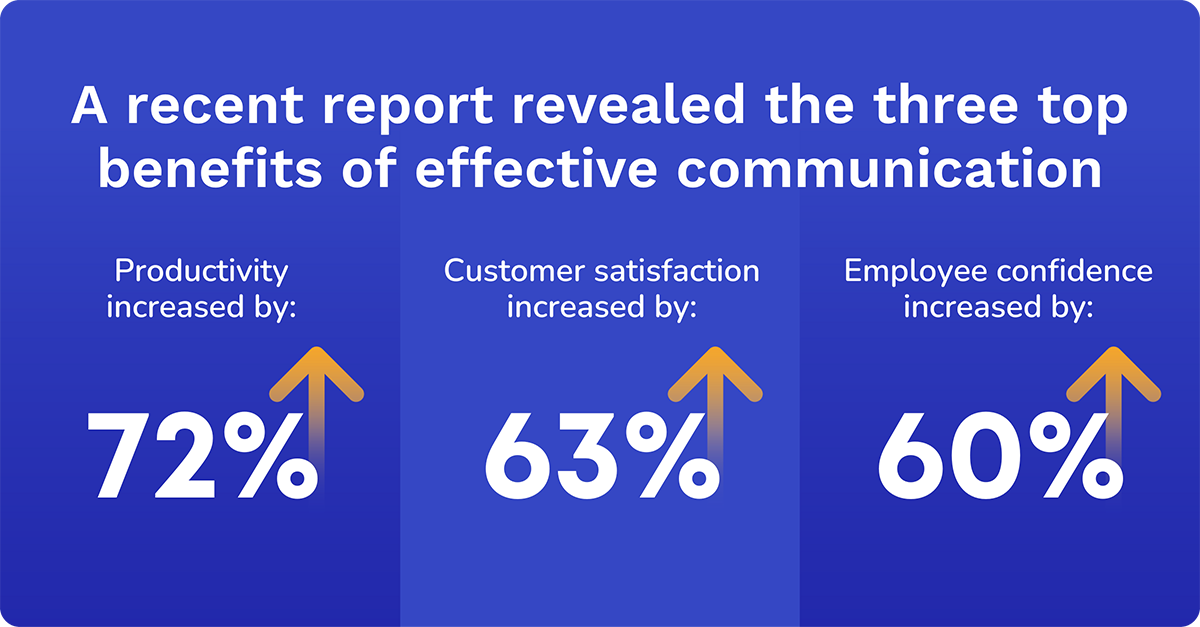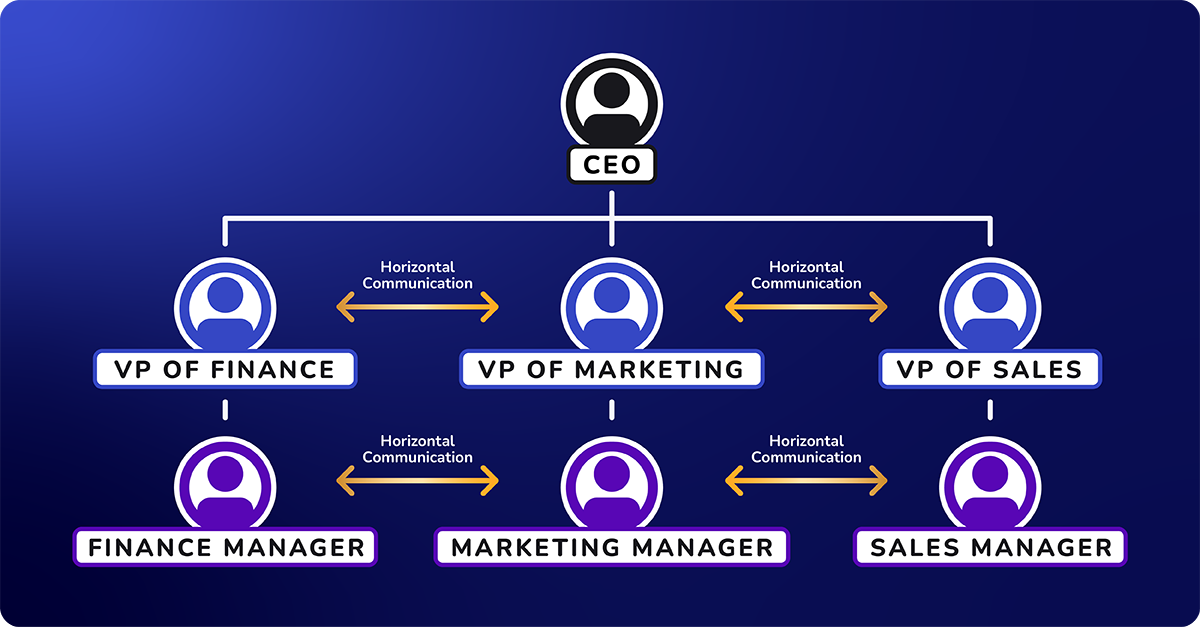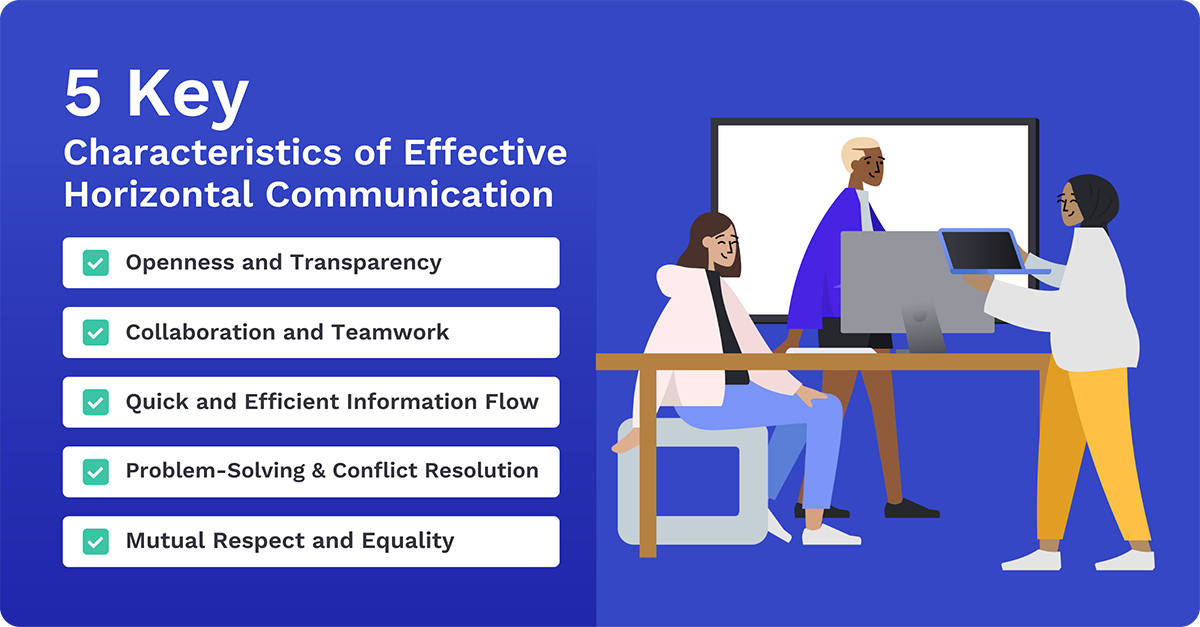Research shows that horizontal communication effectively increases work performance and productivity. It’ll pay you to improve yours. Find out how, free.

.webp)
Effective internal communication is the backbone of every successful organization. Learn the ins and outs of internal communications with our research-backed white paper.
Access NowIn today's digitally dominated workforce, communication is everything. From building strong teams to fostering collaborative environments, it's the lifeblood of any organization.
The Harris Poll/Grammarly Business The State of Business Communication: New Threats and Opportunities 2023 report reveals the three top benefits of effective communication. Responses from business leaders put increased productivity first (72%), followed by customer satisfaction (63%), and employee confidence (60%).

But there are many different types of communication including vertical communication that flows from top to bottom or bottom to top. Traditional top-down communication features messages that are relayed from management to employees, while bottom-up stems from employees and flows to management. Another example is diagonal communication, between different departments and hierarchical levels.
One critical form of communication that is often overlooked is horizontal communication. Also known as lateral communication, this type takes place between employees on the same tier or hierarchical level. It plays a key role in boosting operational efficiency and the ability to effectively manage projects. It is also useful for promoting team interactions.
Whether you are a team leader, a project manager, or an enthusiastic professional, understanding horizontal communication can empower and equip your workgroup or organizational team with the necessary communication tools for success.
In the field of organizational communication, horizontal communication refers to the exchange of information between individuals or groups on the same hierarchical level. This communication method is typically seen within departments or between colleagues working on the same project. Policies, procedures, or contemporaneous data, which reflects current and concurrent occurrences, make up a large portion of the content in horizontal communication.
By enabling employees to discuss work-related subjects, horizontal communication cultivates a collaborative atmosphere in the organization. This promotes efficiency and problem-solving and helps to foster meaningful interdepartmental cooperation. Furthermore, it encourages staff functions to be carried out smoothly without unnecessary bottlenecks.
A study researching the Impact of Effective Business Communication on Employee Performance proved that there is a significant relationship between horizontal communication and employee performance. But then, effective communication in any business entity has a great influence on the performance of employees.
The study, undertaken in Greece in 2020, examined horizontal, upward, and downward communication forms, focusing on their impact on employee performance. It concludes that all three “render a great influence on the level of employee commitment on the job.” All three also have a positive impact on organizational growth in the long term.
“The general trust among employees can build up in an organization if every person is committed to engaging in effective communication.”
Greek study
An important consideration is that while upward and downward forms of communication are commonly practiced in organizations, horizontal communication is often neglected. Yet business management basics strongly emphasize horizontal communication as a vital tool for building relationships. It recognizes that when horizontal communication is effective, it ensures seamless functionality within any organization. It also enables businesses to effectively manage job titles, resolve organizational change, and maintain a positive work environment.
The flow of horizontal communication is more informal than vertical communication and tends to be more collaborative in nature. It takes place laterally, from one department or function to another, and from one project team to another, which helps enormously in the coordination of activities.

Effective horizontal communication relies heavily on active listening. This is because the information can often be complex due to the internal comms involving more than one staff function or job title. Careful listening helps to ensure that communication is accurate, clear, and succinct, enabling the team to move forward with mutual understanding and agreement.
In this age of remote work and increased use of technology, visual collaboration tools like virtual meeting spaces and project management software have become essential for facilitating horizontal communication. A vast range of tools helps teams to collaborate over long distances, streamline workflows, and effectively solve issues.
The primary differentiator between horizontal and vertical communication lies in their nature and direction. Vertical communication refers to the flow of information and directives either upwards or downwards within a hierarchical organizational structure. On the other hand, horizontal communication relates to interactions that take place among individuals or groups on the same level of the organizational hierarchy.
Upward communication is a component of vertical communication. It involves a process of information that moves from the lower levels of an organization, upwards to the higher ones. This includes feedback, reports, and other important details from employees to their supervisors or managers. For instance, an engineer reporting a project barrier or obstacle to the project manager or a customer service representative conveying customer feedback to management utilizes upward communication.
Downward communication, on the other hand, refers to the transmission of information, orders, guidelines, and strategies from those higher up in an organization to those lower down the ladder of command. Examples include a director providing strategic plans to department managers or a team leader assigning tasks to team members. Ensuring effective listening when there is a downward flow of communication can lead to better understanding, employee satisfaction, and improved productivity in the long run.
Turn your internal communications strategy around today

For horizontal communication to be effective, it needs to be open and transparent with a quick, efficient flow of information. Collaboration and teamwork are essential for problem-solving and conflict resolution. And there must be ongoing mutual respect between those communicating on this level.
Openness and transparency are particularly important characteristics that make horizontal communication effective. Those participating in horizontal communication should be straightforward and honest when expressing their views, ideas, and feedback. Furthermore, the content of all communication must be clear and precise to avoid any potential misunderstandings. This transparency not only fosters trust but also encourages effective communication within the team.
Effective communication on a horizontal level promotes a culture of collaboration and teamwork. Since this type of communication often takes place between team members working towards a common goal, it encourages cooperation and mutual understanding. As a result, it leads to improved productivity, reduced conflict, and better problem-solving within the team.
Generally, timely and efficient information sharing is vital for productive internal communications. Wasting time can lead to delays in decision-making, productivity, and it can affect the overall effectiveness of project management. Therefore, to be effective, horizontal communication needs to be quick and efficient while ensuring that the information shared is accurate and up-to-date.
Problem-solving and conflict resolution are key benefits of horizontal communication. Promoting open dialogue and discussions provides a platform for employees to share their concerns, express their ideas, and collectively solve issues. This can help greatly when it comes to building a positive workplace culture. It also helps to increase interdepartmental cooperation.
Another significant characteristic of efficient and productive horizontal communication is mutual respect and equality. Since this type of communication happens between individuals at the same hierarchical level, it’s important for it to occur within an environment of respect, where each person’s viewpoint is valued and considered with dignity. This not only fosters a healthy work environment but also promotes active listening and effective communication.

The primary purpose of horizontal communication in the workplace is to facilitate coordination and cooperation among individuals and departments. Often prevalent in project management and small business environments, horizontal communication helps bring together different functional areas of the organization to achieve shared objectives.
For instance, in product development, engineering and marketing teams might engage in horizontal communication to align their strategies. Such communication ensures that the engineers design a product that meets market needs, while the marketing team correctly positions the product in the marketplace.
Additionally, effective horizontal communication is critical in fostering a positive work culture and building relationships among team members. It encourages openness and transparency, thereby fostering trust. Simultaneously, it supports the sharing of ideas, thereby promoting innovation and problem-solving. Quick and efficient information flow through horizontal interaction aids in rapid decision-making.
Importantly, horizontal communication helps address and mitigate any interdepartmental conflicts. With regular and open communication, issues can be spotted and addressed before they escalate. This is yet another reason why horizontal communication is such a vital tool for conflict resolution within a collaborative environment.
Horizontal communication can take place through a variety of formal and informal channels, both orally and in written form. The use of different methods usually depends on the organization's culture, the communication's nature and urgency, and the technological tools available. Let's look at the two primary methods, oral communication and written communication.
Bear in mind that the two methods are very different and are commonly both used within organizations for internal communication.
Oral communication refers to face-to-face interactions, conversations done via a voice phone call, and virtual meetings. It is generally faster than other forms of communication, and it allows immediate feedback, making it useful for quick decision-making processes and resolving urgent issues.
The facial expressions, tone of voice, and body language elements vary in these different platforms. However, they facilitate a more complete understanding, reducing the possibility of miscommunication. At the same time, oral communication may lead to misunderstandings if the message is not correctly conveyed or properly understood.
Note that effective listening is an essential trait in oral communication.
Written communication includes emails, reports, memos, and instant messages. This method is especially useful for detailed instructions, policy changes, or any information that needs to be stored or documented. A well-drafted written communication serves as a record and proof for future reference.
For instance, an email outlining a new business strategy can be referred back to over time, ensuring consistency in understanding across the team. A study guide or test prep material for team training would typically be shared as written communication for revision purposes.
Despite its advantages, written communication can sometimes lack the personal touch and immediate feedback of oral communication. Therefore, it should be clear, concise, and well-structured to prevent misinterpretation.
Like all types of communication, horizontal communication comes with its own set of advantages and disadvantages. Understanding these can help businesses manage their communication practices more efficiently.
Horizontal communication brings about a sense of unity among employees, fostering better teamwork and collaboration. Employees working in a horizontal communication network feel valued and part of a collective effort and are more likely to show greater job satisfaction and productivity.
Additionally, it allows for quick decision-making and problem-solving, as information flows freely across different areas of the organization. A shared understanding of business management basics and organizational goals and overall targets are facilitated by such communication.
Horizontal communication also fosters innovation, as it encourages the exchange of ideas across different departments. For instance, a marketing team member might propose a product improvement idea to the design team, leading to a product update that significantly boosts sales.
Incorrect use of horizontal communication can lead to miscommunication or serious distortion of information. Messages may get misinterpreted or twisted as they pass from one person to another, leading to possible confusion and chaos. This is a common problem with all forms of communication.
Furthermore, without clear direction or control excessive horizontal communication can end up wasting time and leading to reduced productivity. Care must be taken to ensure that communication is streamlined and purposeful.
Finally, horizontal communication might cause issues in organizations with a rigid hierarchical structure. Staff members might bypass their superiors to get faster responses, which could lead to feelings of disrespect or conflict among higher-level employees.
The world of business is replete with instances where horizontal or lateral communication has contributed significantly to successful outcomes. For instance, consider a tech start-up assembling a custom software development team. Horizontal communication takes place when software developers, architects, and testers engage in short, daily stand-up meetings, sharing their status updates and blockers. This enables them to synchronize their tasks, overcome obstacles, and enhance collaboration, ultimately streamlining the software development process.
A more corporate example could involve the marketing and sales divisions of a company. They frequently need to collaborate to understand the customer's needs better, drive sales strategies, and align on promotional activities. This involves a high degree of horizontal communication between the two teams.
On a different front, horizontal communication can often be observed in the context of academia. In universities, professors hailing from various disciplines often join hands to work on an interdisciplinary study or research project. Regular meetings, updates, and discussions between these individuals are classic examples of horizontal communication.
Turn your internal communications strategy around today

Organizational communication expert, Professor Michael Papa highlights some of the barriers to horizontal communication. He warns that when there are differences in style, personality, or roles among coworkers, horizontal communication may not run smoothly. Generally, horizontal communication problems occur because of territoriality, rivalry, specialization, and a simple lack of motivation.
“An organization that has relied on rigid, formal styles of communication in the past may find it difficult to switch to more employee-directed, horizontal communication. Lingering expectations from the old system can significantly inhibit the implementation of horizontal communication.”
Professor Michael Papa, Central Michigan University
Researchers from Universitas Kristen Indonesia Maluku on the Spice Islands conducted a study in 2022 on the effect of horizontal, diagonal, and vertical communication on employee performance. It followed previous studies that showed a strong link between communication and performance.
Recognizing that “communication is the main tool for perfecting relationships within the organization,” they focused on horizontal and vertical communication as formal internal communication methods. And they examined diagonal communication as a form of external communication.
The study results showed that “horizontal communication has a relationship with increasing work performance.” However, some barriers include the division of work units, employees’ different opinions and interests, and varied experiences and backgrounds.
“Good communication will be established if there is openness and trust between the people involved in the organization. In this case, the important role of leadership is to determine the effectiveness of communication, because through communication it will increase the expectations and trust of employees to participate in the policy-making process.” Universitas Kristen Indonesia Maluku study
Ultimately, the results indicated that when used together, horizontal communication, vertical communication, and diagonal communication had a significantly positive 78.9% effect on the performance of employees surveyed. Interestingly, horizontal communication was the most dominant variable that affected the performance of employees by 64.9%.
A robust horizontal communication strategy can facilitate better interdepartmental cooperation, quicker problem-solving, and improved overall productivity. Here’s how you can go about crafting one:
Identify key stakeholders across departments and functions that need to collaborate. Get their buy-in for effective communication flow.
Establishing clear goals that horizontal communication should aim to achieve is equally important. This could include promoting better understanding and cooperation among team members, improving response time to issues, building stronger relationships, and enhancing overall efficiency. Having clearly defined goals allows teams to measure the effectiveness of their communication efforts and refine them over time.
The next step involves identifying the ideal communication channels for your organization. Thanks to modern information technology, teams can leverage tools such as Slack or Microsoft Teams for instant messaging, Asana for task management, or Zoom for virtual meetings. The selection of the right channels should be based on your team’s requirements, ease of use, and the kind of interaction it can facilitate.
Once channels are set, devising a plan that outlines who communicates what, to whom, when, and how is crucial. The plan should illustrate the procedure to follow for regular updates, conflict resolution, and escalation of issues. It should advocate for active listening, and open dialogue, and include constructive feedback as the guiding principle of horizontal interaction.
Provide training and coaching to employees at all levels on best practices to make horizontal communication more effective. Reinforce the importance of cross-silo information sharing.
Develop metrics and KPIs to track the progress of horizontal communication across desired parameters like speed, transparency, engagement levels, and so on.
Reward and recognize teams and individuals who display great collaboration and communication across functions through incentives, awards, and similar initiatives.

Horizontal communication is an important element of modern workplaces. Apart from anything else, it provides an information flow that supports collaboration, problem-solving, and innovation.
First, we must dispel a common misconception. Usually, when we talk about horizontal communication, people tend to limit their thinking to verbal interactions or formal meetings. This is a narrow view. In reality, horizontal communication can take many forms including emails, project management tools, visual collaboration tools, and even more informal, social exchanges.
Effective and efficient horizontal communication begins with an examination of the current communication processes and identifying areas that need improvement. This may involve soliciting the views of the employees on the current communication methods and their effectiveness.
Cerkl Broadcast’s internal communication platform is ideal for every form of communication, including horizontal channels. It provides a centralized hub, ensuring that internal communicators can easily access and manage information. This, in itself, makes planning considerably more effective.
A top feature of the Broadcast platform is its omnichannel capability. This allows employees to select the channels they prefer to use. Other features include outstanding content scheduling, customizable templates, and great analytical and feedback tools.
Do you want to maximize the effectiveness of your horizontal communication efforts? Access our free resource and set up an effective communications strategy today.

Turn your internal communications strategy around today
What is horizontal communication? Horizontal communication involves the exchange of information, ideas, and messages among individuals or departments at the same organizational level, facilitating collaboration and coordination.
What is the difference between downward and horizontal communication? A downward channel of communication flows from higher to lower levels in the organizational hierarchy and involves instructions, guidance, or feedback. Horizontal communication occurs at the same hierarchical level, promoting peer-to-peer interaction.
What is an example of horizontal conversation? An example of a horizontal conversation is when team members from different departments collaborate on a cross-functional project, sharing insights and updates.
Which is an example of lateral communication? An example of lateral communication, a synonym for horizontal communication, is when colleagues within the same department discuss and coordinate tasks to achieve common goals.

Turn your internal communications strategy around today